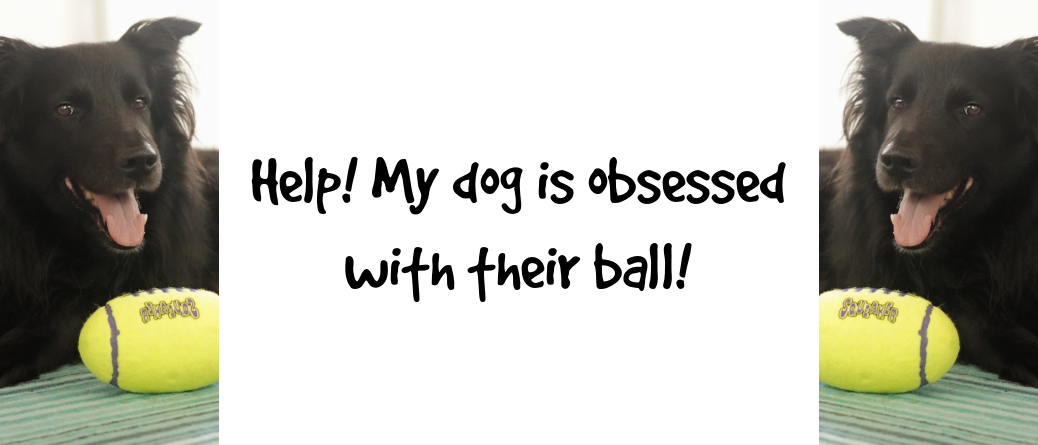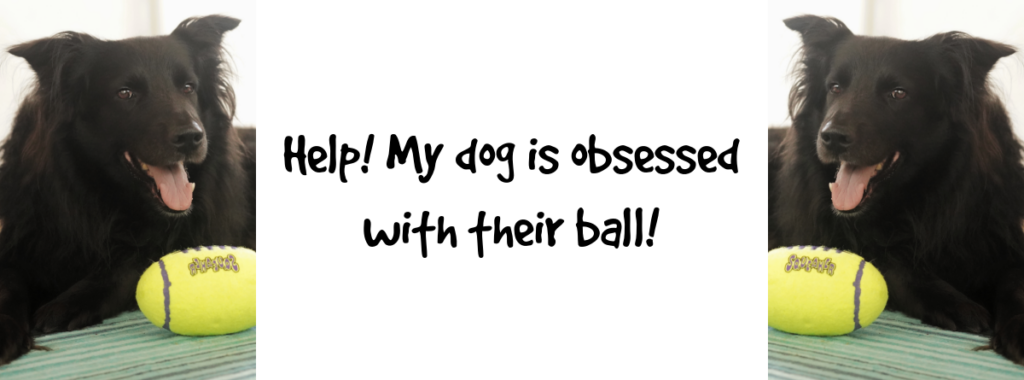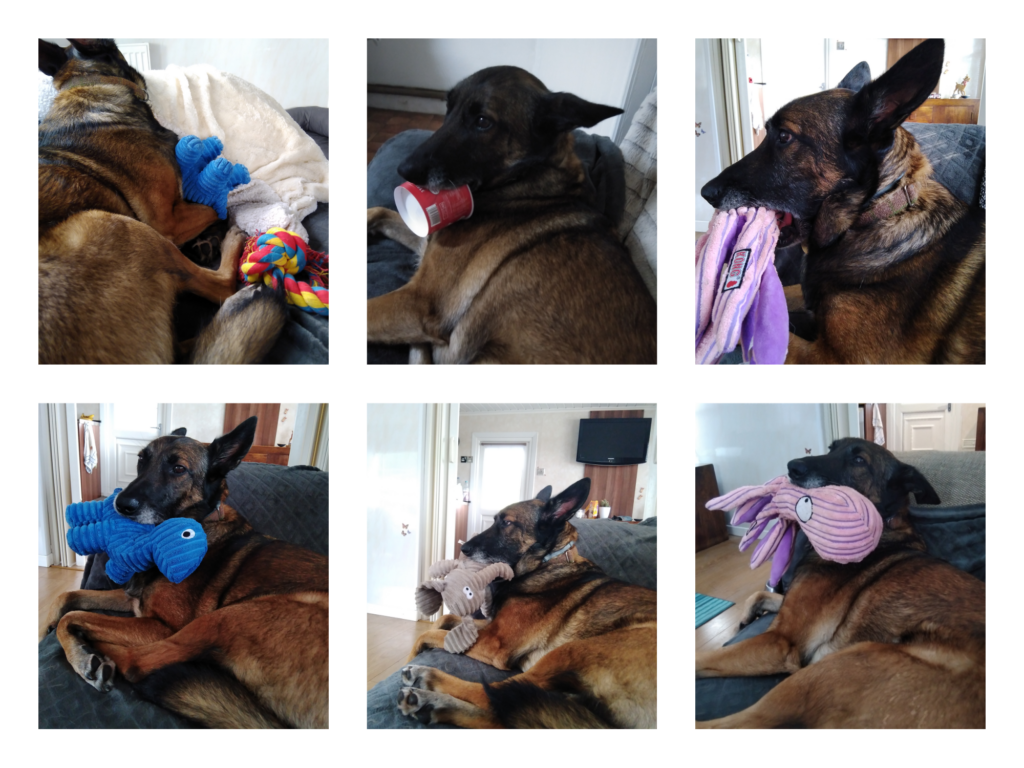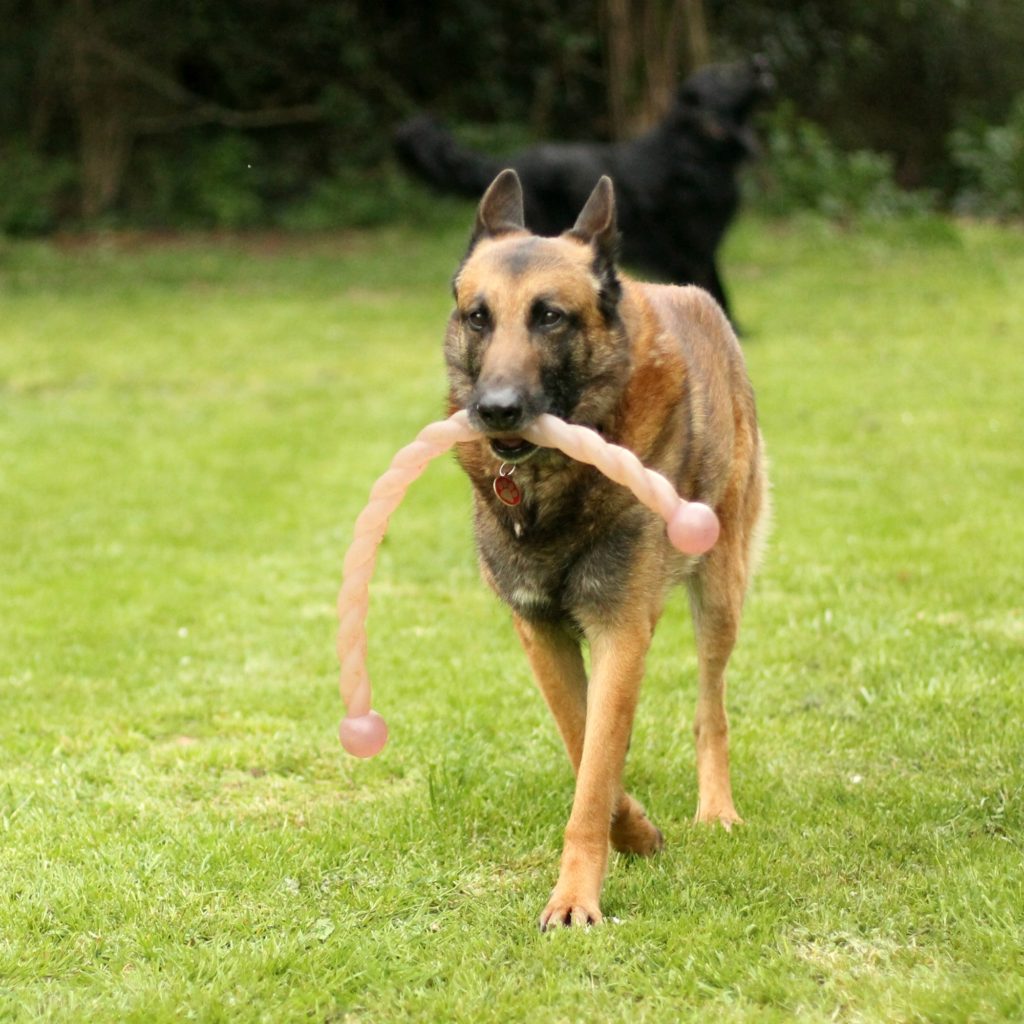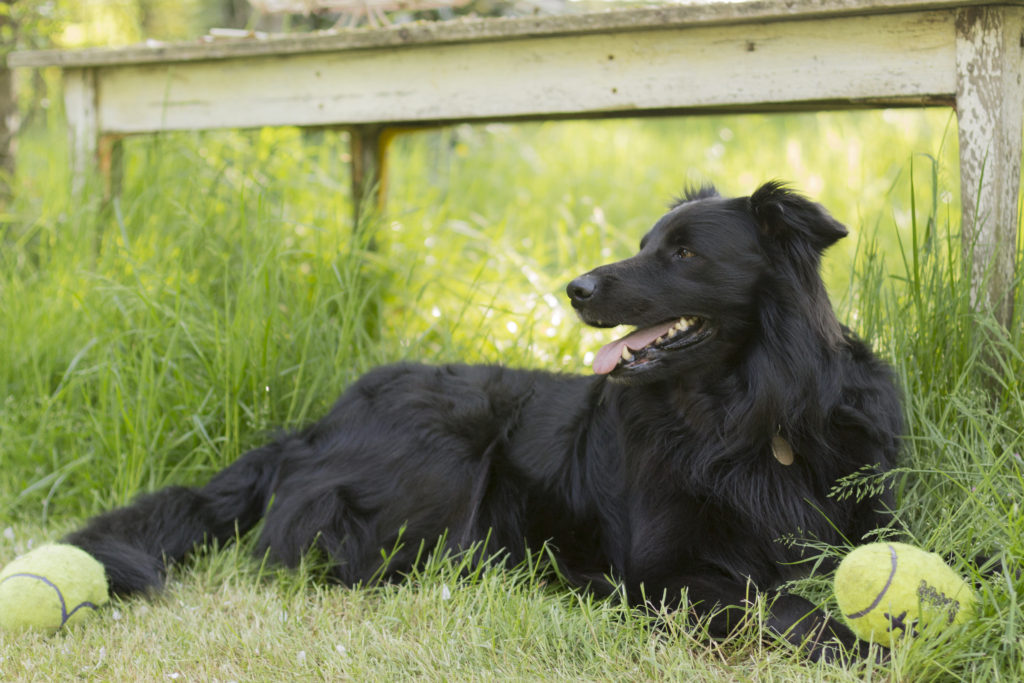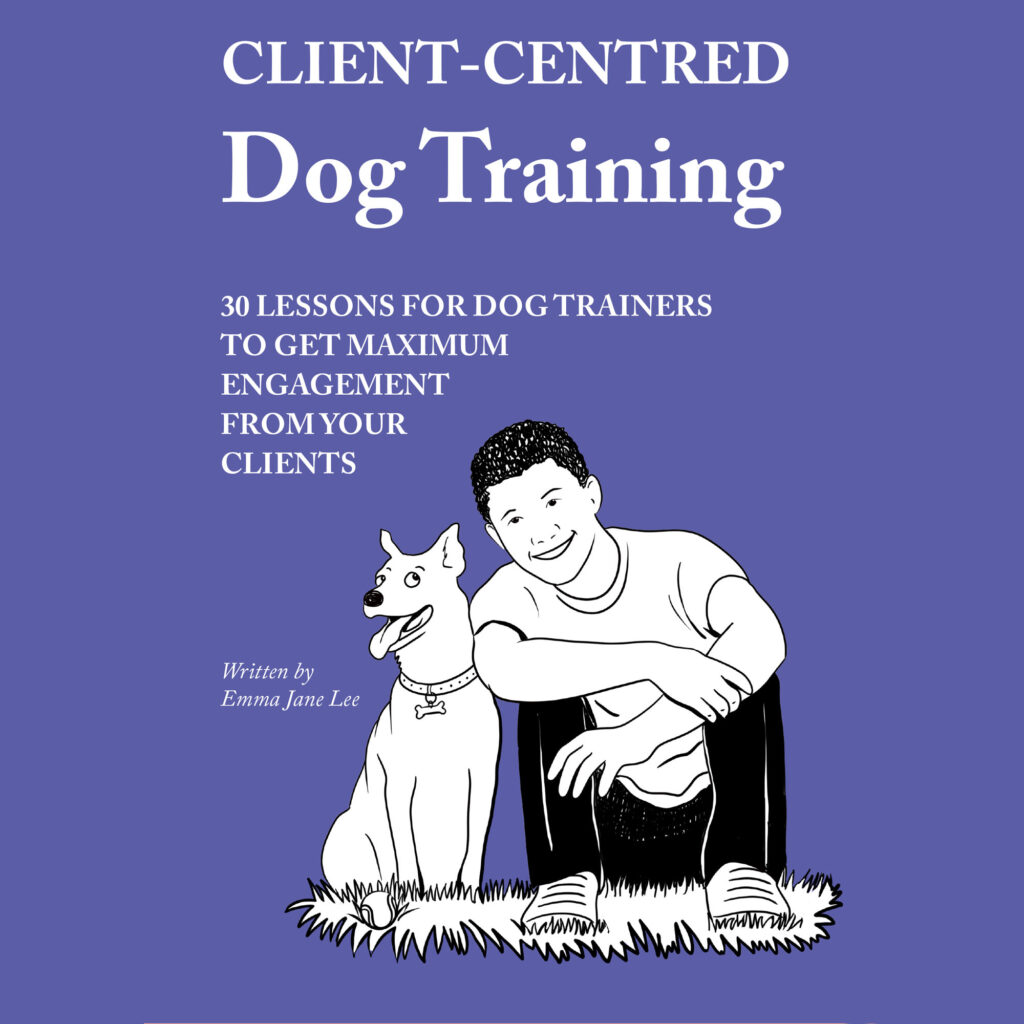* Ball, not balls. That’s different. See a vet.
When I watch videos of free-ranging dogs, you don’t tend to see them all glazed-eyed, barking at passers-by to throw them a ball. They’re not the dogs you see on those cutesy videos of dogs dropping balls at the foot of statues, hoping for a game.
What does this tell us?
Compulsive behaviour with balls is most likely both a product of pre-programmed hardware and also a product of software we’ve installed ourselves. Simply put: genes and learning.
How can genes be at work, you may well ask.
Well, have you ever seen a streetie fixated on a ball?
Why on earth would humans put compulsive tendencies into dogs when they were breeding them?
More likely, the dogs were bred for other behaviours, and compulsive behaviour kind of hitched a ride with the other predatory behaviours and appetitive behaviours that we used to create a handful of western breeds. Compulsion is a full-blown version of things we might call ‘motivation’, ‘desire’, ‘trainability’ and ‘focus’ or ‘tenacity’ and ‘endurance’. In other words, it benefited humans to have dogs who’d work hard.
From my own experience, this seems to be very much focused on an even smaller handful of breeds within the 400 or so recognised breeds. You know, the kind you find in airports as sniffer dogs or ones we pride as having constructs like ‘high drive’. There are probably only twenty breeds or so who really fit into this list, and then an even smaller handful who regularly produce such ‘driven’ dogs that ordinary guardians find themselves with a nightmare on their hands.
So, not scenthounds, on the whole. Mostly because life doesn’t give them an opportunity to play with stuff as a puppy, but many new guardians of our adopted Anglos, beagles, Ariègeois, Poitevin and Gascon Saintongeais are more likely to complain of another fault: not being interested in toys much at all.
And not pointers and setters. I mean, you want them to point at birds or set. You don’t need them much to retrieve them.
Good luck getting setters to do much work other than run and be incredibly lovely anyway. They’re often dogs that guardians tell me aren’t motivated by food or toys. I’d like to see setters at work in airports, galloping down the baggage carousels, ignoring the desperate pleas of their handlers.
And not terriers, either. Let’s face it: to terriers, everything is a toy. Shoes, remote controls, pens, packages, carpets, small furries… or sometimes their own tail if they’ve been deprived at an early age. Bull terriers? They’re a bit special, and English bull terriers can certainly develop compulsive behaviours, but it doesn’t usually involve balls or other portable toys.
And not mastiffs or livestock guardian breeds. Because… important resting to be done.
That leaves us with some gundogs such as spaniels and retrievers (though not the pointers and setters on the whole) and lots of herding dogs, including ones from the British diaspora (including collies and Aussies) and from mainland Europe (including Malinois, Beauceron and German shepherds).
You know, the kind of dogs that you do find in airports doing actual work, hunting for missing individuals, tracking down drugs or the kind of dogs you find herding sheep for eight hours a day.
Borderline compulsive behaviour around toys can be useful for the working dog. Or, more to the point, useful to the guardians or handlers of working dogs. Not so useful for the average guardian.
Fairly occasionally, I find compulsive behaviours pop up in these breeds even if they weren’t bred to work. Sure, your cocker spaniel may look like a perfect show champion, but there’s no reason mum and dad show champs can’t throw out a working-dog-under-the-hood every now and again. That’s how genes work.
Just as, likewise, every line of working dogs can throw out a completely ‘lazy’ mattress-backed dog who has zero desire to get out of bed of a morning, let alone go sniff suitcases in return for a ball.
So that’s genes.
They account for why I’ve had two toy-obsessed malinois.
I mean, around 7pm, she even starts the glacial shift of toys from the toy box to the bedroom. There are literally more toys than space for a very small dog. It’s like living with a Disney-obsessed five-year-old with very generous relatives.
When Tobby arrived, he only put his toy down to pee or eat. When he died, he’d dropped his favourite toy somewhere in the garden and when I found it three weeks later, I wept for hours.
But there’s also dogs like my lovely girl Flika who never had a toy in her mouth and didn’t seem to care. Mouths were for cake and sandwiches, not toys. Probably more a case of never having been taught as much as lacking normal malinois genes. That said, the number of shelter-related behavioural problems with shepherds that can be fixed with toys is higher than you probably imagine. Spinning in circles, destructive chewing, biting the lead, nipping volunteers getting them out of kennels, self-mutilation… much of this can be stopped in our shelter simply by giving the dog a toy to carry.
We also have to understand that compulsions can be different. Malinois and German shepherds, for instance, seem to just like holding the item. Lidy sits next to me for about an hour sometimes, just holding her stuff. She’ll look at me and her head nods as if to say she’s on duty and ready for work. ‘Alright there? I’m just holding this plushie for you…’
For retrievers and flushing/retrieving dogs like spaniels, however, that can be very different. For them, the chase is the thing, not the grab-bite or hold. I’ve found that herding breeds from the UK diaspora (mainly collies) can also be addicted to the chase and collection. This pseudo-predation which mimics some aspects of how canids hunt in the wild, has been steadily strengthened through breeding in order to make the dog good at their job. It doesn’t take much to awaken that inner need. Toys for many dogs function as self-reinforcing, leading to a neurological cascade that dogs find very rewarding.
I’d just like to make an aside to point out that dopamine isn’t a ‘feel-good’ neurotransmitter as some people might try to have you believe. It’s simply one that tells the body what to find rewarding or not. Being rewarding and being pleasurable don’t have to be the same thing. I pick at my nails and compulsively bite the inner bit of my cheeks because something in my body thinks it’s rewarding. Neither of them are pleasurable experiences. Dopamine drives all kinds of behaviour from learning and memory to addiction, so it’s a bit facile to dismiss it as ‘feel good’.
It may very well feel good, but we can’t ask the dogs and they can’t tell us. If it’s a compulsion, I’m pretty sure there are lots of moments that don’t feel good at all. I also notice that a lot of dogs lapse into compulsions when they are stressed, as a kind of coping mechanism. We might even call this self-soothing behaviour, but again, that’s not to imply it’s pleasurable; I shout at politicians on Twitter when I’m anxious or not coping. It doesn’t make me feel any better. Lidy paces round in circles. It might fill a vacuum but I don’t think it feels good for her.
While I’m taking down myths, can we also stop talking about parading as why dogs like holding things?! No idea where this came from, but dogs don’t parade in my opinion. I’ll explain why. Firstly, complete dearth of information. I’ve seen one bit of ‘science’ that proponents suggest makes parading a thing for dog. It was a blog post about an observation of two village dogs in North Africa. Not science. Worse, it was a report from three years of research with only two incidences. Second, parading has no part in the general predatory motor sequence. Hawks don’t parade. Bears don’t parade. Wolf ethologists aren’t arguing to put ‘PARADE’ in the predatory behaviours of wolves. Literally no other animals do this, so let’s stop suggesting it’s a thing? Also, while I’m at it, it’d come after the GRAB-BITE when the dog has entered consummatory behaviours. If dogs don’t know how to dissect or consume a dead pigeon, that’s on domestication processes that have stopped them knowing what to do with it. That’s completely different than it being a motor sequence. Motor sequences should generally be true across most animals in the species. Parading isn’t. If it were, streeties and village dogs would also do it with the same frequency as your typical labrador. They don’t. My old boy Ralf once picked up a dead boar piglet and carried it about. He didn’t do that because he was showing it off or parading. He did it because he was a bit labrador, a bit shepherd and 100% dog, and his DNA said ‘pick up the bloody thing’ then didn’t tell him what to do with it afterwards no doubt because of domestication. Somehow, I reckon we’ll find out eventually that selective breeding led to the enhancement of appetitive behaviours designed to make us want to do things, and the truncation of consummatory behaviours, which is why most dogs are scavengers other than dingoes and singing dogs. It might also explain why some of our most ancient ‘breeds’ like Nordics and some Asiatic breeds can be found in the neighbours’ chicken pen. Most streeties and village dogs live by scavenging. If they don’t ‘parade’, at least regularly and reliably across the majority of dogs, then it’s not a motor sequence thing. Domestication processes seem to have involved dogs ‘forgetting’ at an ethological and neurological level what to do with prey or not needing to consume it. Parading is an explanatory fiction at best. It’s not an explanation about why dogs like balls.
Now those myths are out of the way… how do you know it’s a compulsion if your dog seems fixated or obsessed with a toy such as a ball?
Firstly, there will be physiological signs such as panting, dilated pupils and a wide grimace.
There may also be behavioural signs like jumping up at you to get the toy, grabbing or biting. The dog might bark at you if you refuse to relinquish the toy quickly enough. They may refuse to relax without the item. They might search for the item to try and access it themselves, or they might do something to try to make you get it for them, like whining or barking.
There can also be emotional signs, like frustration or loss of inhibitions. If your dog doesn’t normally jump or grab, but they do when you have their favourite toy, then that can be a sign that their normal inhibitions have no say in how the dog is behaving. They might appear sad or depressed without the item.
We can also see compulsions with what the dog does with the toy. Perhaps they’re constantly retrieving it and dropping it at our feet for it to be thrown again. Welcome to the world of retrievers, people! They’re getting internal rewards for doing what they’re supposed to do, just the same as I do for every word that forms on a blank page. Perhaps they refuse to relinquish the toy if they suspect you won’t return it. Perhaps they guard it or run away with it.
Much of this brings us to what the dog has learned YOU do with the toy. Do you always throw it again? Even if you resist for ages? Of course they’re going to bring it to you if that’s what they want.
Why is this problematic, you may well ask.
The first is that compulsions do not feel nice. They exist to fill a behavioural vaccuum when we’re anxious, but the adrenaline they produce heightens the anxiety they experience. Chasing is not comforting. If dogs are compulsive carriers, then why do they feel the need to get all their comfort from this source? Why do our shepherds have behavioural problems that are assuaged by toys? Because they’re stressed and anxious.
Second, compulsions can fuel behaviour that ends up being physically dangerous. Not just dogs following balls off cliffs or into dangerous rivers or tidal currents, but dogs who end up with repetitive strain injuries, with damaged cruciates, with joint strain. Pretty much every specialist vet who deals with arthritis or mobility issues will have posts on their social media about the dangers of ball throwers. The surface of some toys can damage the enamel of teeth. A dog who grabs a ball mid-flight can end up biting it and the toy getting stuck in their mouth… the horror stories are enough to make you wish you’d never introduced your dog to toys in the first place.
So what can we do?
The first two things are prophylactic. Don’t snigger.
More careful breeding of working dogs and show lines of working breeds is needed. We don’t need compulsions in dogs and the fact that these compulsions rarely happen in dogs who are responsible for their own reproductive choices tells us that it’s a behaviour we’ve built. It’s not ‘normal’. Of course, people may need dogs who work. No showline cocker spaniel needs to be bred to be that into toys that they are frantic and out of control. No golden retriever should be toy-obsessed when the heritability of musculoskeletal problems in Goldens is enough to make a geneticist weep. Breeding for beauty shows rather than behaviour is causing our dogs a lot of problems, if you ask me.
Second, if you have a breed that’s susceptible to chasing or carrying compulsions, make sure you work carefully with a good dog trainer from their earliest days in the home through their teenage times.
It goes without saying that they need a really good ‘drop’ – I suggest Chirag Patel’s method. Trade just is not enough, I’m afraid, and all you’re doing is getting yourself into a habit where they’ll only surrender an item if you have something of the same value to offer. That’s like a drug addict telling you that you can take their line of coke if you’ll give them another line of coke. That’s a recipe for disaster. I want a dog that will drop something they’ve decided is valuable with lightning automaticity and will also leave the thing they’ve dropped without drama.
Here’s Lidy practising.
She dropped a dead pigeon wing last week in return for a cheap biscuit, so keep working on your drop.
Keep their range of toys wide, make sure you build really, really strong cues for both the beginning and end of behaviours.
I also recommend you make sure you practise the following five activities:
#1
Go back in the predatory motor sequence.
Dogs who have compulsions often get ‘stuck’ at one particular point – often the point their breed was selected for. That’s to say spaniels may find the CHASE-GRAB/BITE aspect of the motor sequence more fun than the ORIENT – EYE – STALK bit. Collies might get stuck on the EYE-STALK-CHASE bit.
Going back in the predatory motor sequence means focusing on earlier points of the sequence and building those up too. So for dogs who enjoy compulsive games of fetch, doing things like scent work can be really useful. It’s building up their other muscles. In fact, this is how working dogs work in artificial situations which use their talents. Sniffer dogs spend all their time sniffing… in return for…. a game of fetch or tug.
If you’re a dog trainer, whether you see this as Premacking (low-value behaviours being followed by opportunities for high-value behaviours) or whether you see this as respondent associations (chasing is great, and if sniffing/locating always precedes chasing, then sniffing/locating will also become great too by association) it doesn’t really matter to me.
Enrichment using earlier stages in the PMS can help your dog become a little more of an all-rounder.
#2
Go forward in the PMS.
If you’ve got a dog who is fixated on the appetitive bits of the predatory motor sequence – the acquisition bit – then add in some of the consummatory bits too. That’s to say put in some food toys. Dopamine dips when we acquire food sources. Eating in itself works on different mechanisms. Not only would I putting in some KILL/BITE stuff like games of Tug, but I’d also be putting in DISSECT activities and also chewing, gnawing and even just a little productive licking. Digestion is our sedative friend. Be wary of frustration with this but snuffle mats, pickpockets and even having to destroy items to get to the toy can really help activate a whole load of other predatory muscles.
When I look at my lovely Heston (50% shepherd, 25% labrador, 25% cocker spaniel) he’s a living, breathing genetic pool of CHASE – GRAB/BITE and we work every day to keep his pool of enrichment activities building up his other skills otherwise he tends to fixate on one single toy.
#3
Make the toy conditional on completion of another task.
When Heston gets a bit obsessed with his Kong Rugby squeaker balls, I bang in other toys first. A short game of tug (KILL/BITE) predicts a game with his rugby ball. A tennis ball precedes the rugby ball. A soft plushie precedes the rugby ball. A flirt pole precedes the rugby ball.
You’re using Pavlov as your friend here, using the other object to predict the appearance of the second toy. You can build up a much wider arsenal of favoured toys and broaden out the dog’s repertoire simply by using this pattern.
When you’ve got it, you can then make the play with the less favoured toy last longer than the play with the favoured one. Again, this is what working dog handlers do: the activities gradually grow as access to the reinforcer grows less and less. You can’t have a springer who sniffs one suitcase and wants you to throw the ball…. you want them to search the room full and then get the ball for a short moment. Because of Pavlovian mechanisms, the search in itself becomes as fun as the ball.
If you’re technically minded, you’re using respondent second order conditioning and successive approximations. If that means stuff to you, go for it. If it doesn’t, find yourself a trainer who can explain it and show you how to do this with your dog.
#4
Work on both their impulse control and their ability to tolerate frustration. Buy a copy of Jane Ardern’s book Mission Control. All dogs can learn to handle themselves but you need to understand the negative emotions that are usually the fallout of compulsive behaviours. You can also work with a behaviour consultant who knows how to help you understand whether your dog has impulse control issues through the use of diagnostic tools such as the Dog Impulsivity Assessment Scale.
#5
If it’s a true compulsion, there can often be underlying anxiety or lifestyle changes your dog needs to help them cope in a world that they’re ill-prepared for. See a behaviour consultant and also a vet. There are drugs that can help with impulse control issues, working on the dopamine pathways, and there are also drugs that can work on balancing the dog out emotionally.
You may feel that you want to try nutraceuticals first, and part of me says ‘OK then’. The other part says that if your dog is as fixated on fetch as an addicted person is with cigarettes, alcohol or drugs, then it is a stonking, huge, welfare issue for your dog.
There’s lots of evidence to show that addictions are in some part Pavlovian for both animals and humans. That’s to say they are very context specific and being in the place where we have habitually got our fix, so to speak, can cause us to feel the need for that fix. If you were always a social smoker or you smoked with a specific group of friends, then you may need to avoid that environment or those contextual factors as you learn new habits. Going back in pubs can sometimes be the trigger for a relapse.
Likewise alcohol and drugs.
Learners may need a fix simply by being in the environment where they learned the habit in the first place.
To train dogs not to be compulsively addicted to fetch, then, may need you to consider all the places your dog played fetch and to take that place or those circumstances out of your repertoire for a while, if not for good.
For instance, if fetch has always been a park thing, you may need to go to different parks in order to do #1-#4 on this list. That’s tough if you’ve got a dog who has learned that your garden is the place for the game…. I’m not kidding but I once worked with a labrador guardian whose dog was compulsively dropping balls to be thrown. The dog was in agony too. The family contacted me about 3 months before they were due to move because the behaviour had got worse. All the packing and the change in routine was contributing to the dog’s anxiety. A change of house and the dog stopped his fixation on the ball.
This might sound crazy or miraculous, but the new house hadn’t been the scene of his compulsion before, and his anxiety dropped after the move. This happens more than you might think.
Of course, house moves and avoiding the context of past addictions aren’t a solution to everyone. A medication schedule alongside a decontextualised modification programme working on new skills in new places that are then deliberately generalised and then finally reintroduced into the original scene of the crime is the way forward here.
If you’ve been an inveterate gambler for years, you don’t go back into the bookies unless you’ve absolutely nailed the earlier bits of your training programme and you’ve got a support mechanism in place to help you should you need to go to Las Vegas for the weekend.
This is also true for lab animals who’ve been forced into addiction by scientists. They too will be distressed and frustrated in the location where the drug was delivered.
The more intense the behaviour is and the longer the dog has exhibited it, the more likely you’ll need to add medications and also change location for your training for at least 3-6 months or so.
A little compulsion can be a good thing in training or in working with dogs. It’s not out of control to see Lidy collecting her plushies before bed. If Tobby wanted to carry around his pink wanger all day and it wasn’t bothering him or me, then fine. That said, there are so many dogs whose guardians are engaging in far too much physical activity to try and stem their dog’s compulsions, forbidding access to toys completely or even causing their dog a great deal of physical pain because they don’t know what else to do other than give in.
Dog trainers: if you’re interested in more than just training tips for working successfully with clients, or you’re struggling to communicate the damage that guardians are doing by indulging or even encouraging compulsions, hop on over to Amazon and snag yourself a copy of my book!
Client-Centred Dog Training: 30 Lessons for Dog Trainers to get Maximum Engagement from your Clients is available now.

